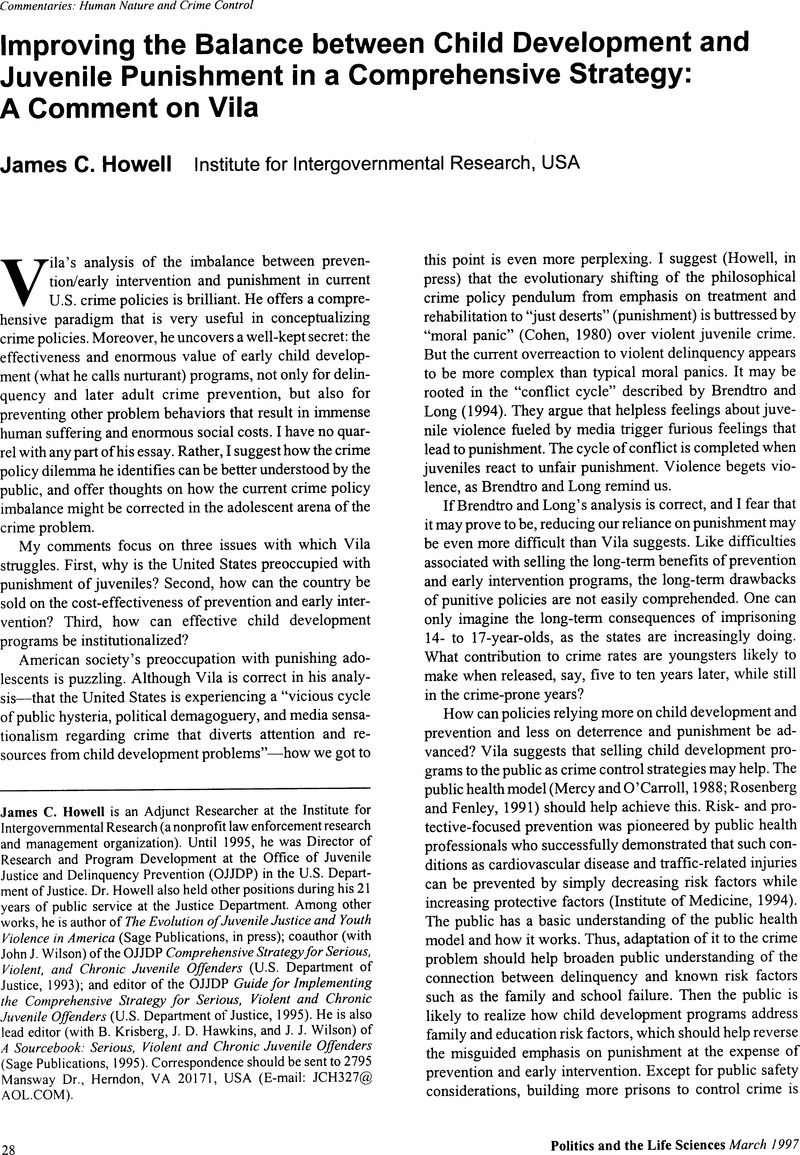No CrossRef data available.
Article contents
Improving the Balance between Child Development and Juvenile Punishment in a Comprehensive Strategy: A Comment on Vila
Published online by Cambridge University Press: 17 May 2016
Abstract
An abstract is not available for this content so a preview has been provided. Please use the Get access link above for information on how to access this content.

- Type
- Roundtable Commentaries
- Information
- Copyright
- Copyright © Association for Politics and the Life Sciences
References
Brendtro, L.K. and Long, N.J. (1994). “Violence Begets Violence: Breaking Conflict Cycles.” Journal of Emotional and Behavioral Problems: Reclaiming Children and Youth 3:2–7.Google Scholar
Brewer, D.D., Hawkins, J.D., Catalano, R.F., and Neckerman, H.J. (1995). “Preventing Serious, Violent, and Chronic Offending: A Review of Evaluations of Selected Strategies in Childhood, Adolescence, and the Community.” In Howell, J.C., Krisberg, B., Hawkins, J.D., and Wilson, J.J. (eds.), A Sourcebook: Serious, Violent, and Chronic Juvenile Offenders. Thousand Oaks, CA: Sage.Google Scholar
Catalano, R.F. and Hawkins, J.D. (1996). “The Social Development Model: A Theory of Antisocial Behavior.” In Hawkins, J.D. (ed.), Delinquency and Crime: Current Theories. New York: Cambridge University Press.Google Scholar
Cohen, S. (1980). Folk Devils and Moral Panics: The Creation of the Mods and Rockers. New York: Basil Blackwell.Google Scholar
Hawkins, J.D. and Catalano, R.F. Jr. (1992). Communities That Care. San Francisco, CA: Jossey-Bass.Google Scholar
Hawkins, J.D., Catalano, R. F. Jr., and Miller, J.Y. (1992). “Risk and Protective Factors for Alcohol and Other Drug Problems in Adolescence and Early Adulthood: Implications for Substance Abuse Prevention. Psychological Bulletin 112:64–105.Google Scholar
Henggeler, S.W. and Borduin, C.M. (1990). Family Therapy and Beyond: A Multisystemic Approach to Treating the Behavior Problems of Children and Adolescents. Pacific Grove, CA: Brooks/Cole.Google Scholar
Henggeler, S.W., Melton, G.B., and Smith, L.A. (1992). “Family Preservation Using Multisystem Therapy: An Effective Alternative to Incarcerating Serious Juvenile Offenders.” Journal of Consulting and Clinical Psychology 60:953–61.Google Scholar
Henggeler, S.W., Melton, G.B., Smith, G.B., Schoenwald, L.A., and Hanley, J.H. (1993). “Family Preservation Using Multisystem Treatment: Long-Term Follow-Up to a Clinical Trial with Serious Juvenile Offenders.” Journal of Child and Family Studies 2:283–93.Google Scholar
Howell, J., Krisberg, C.B., Hawkins, J.D., and Wilson, J.J., eds. (1995). A Sourcebook: Serious, Violent, and Chronic Juvenile Offenders. Thousand Oaks, CA: Sage.Google Scholar
Howell, J.C., ed. (1995). Guide for Implementing the Comprehensive Strategy for Serious, Violent, and Chronic Juvenile Offenders. Washington, DC: U.S. Department of Justice, Office of Juvenile Justice and Delinquency Prevention.Google Scholar
Howell, J.C.(in press). The Evolution of Juvenile Justice and Youth Violence in America. Thousand Oaks, CA: Sage.Google Scholar
Institute of Medicine (1994). Reducing Risks for Mental Disorders: Frontiers for Preventive Intervention Research. Washington, DC: National Academy Press.Google Scholar
Johnson, D.L. and Walker, T. (1987). “Primary Prevention of Behavior Problems in Mexican-American Children.” American Journal of Community Psychology 15:375–85.Google Scholar
Lipsey, M.W. (1992). “Juvenile Delinquency Treatment: A Meta-Analytic Inquiry into the Variability of Effects.” In Cook, T.D. et al. (eds.), Meta-Analysis for Explanation. New York: Russell Sage Foundation.Google Scholar
Loeber, R. and Hay, D.F. (1994). “Developmental Approaches to Aggression and Conduct Problems.” In Rutter, M. and Hay, D.F. (eds.), Development through Life: A Handbook for Clinicians. Oxford: Blackwell Scientific.Google Scholar
Loeber, R., Stouthamer-Loeber, M., Van Kammen, W., and Farrington, D.P. (1991). “Initiation, Escalation and Desistance in Juvenile Offending and Their Correlates.” Journal of Criminal Law and Criminology 82:36–82.Google Scholar
Mercy, J.A. and O'Carroll, P.W. (1988). “New Directions in Violence Prediction: The Public Health Arena.” Violence and Victims 3:285–301.Google Scholar
National Conference of State Legislatures (1996). A Legislator's Guide to Comprehensive Juvenile Justice. Denver, CO: National Conference of State Legislatures.Google Scholar
Rosenberg, M.L. and Fenley, M.A., eds. (1991). Violence in America: A Public Health Approach. New York: Oxford University Press.Google Scholar
Thornberry, T.P., Huizinga, D., and Loeber, R. (1995). “The Prevention of Serious Delinquency and Violence: Implications from the Program of Research on the Causes and Correlates of Delinquency.” In Howell, J.C., Krisberg, B., Hawkins, J.D., and Wilson, J.J. (eds.), A Sourcebook: Serious, Violent, and Chronic Juvenile Offenders. Thousand Oaks, CA: Sage.Google Scholar
Tolan, P.H., Guerra, N.G., and Kendall, P.C. (1995). “A Developmental-Ecological Perspective on Antisocial Behavior in Children and Adolescents: Toward a Unified Risk and Intervention Framework.” Journal of Consulting and Clinical Psychology 63:579–84.Google Scholar
Wilson, J.J. and Howell, J.C. (1993). A Comprehensive Strategy for Serious, Violent and Chronic Juvenile Offenders. Washington, DC: U.S. Department of Justice, Office of Juvenile Justice and Delinquency Prevention.Google Scholar
Yoshikawa, H. (1994). “Prevention as Cumulative Protection: Effects of Early Family Support and Education on Chronic Delinquency and Its Risks.” Psychological Bulletin 115:28–54.Google Scholar
Yoshikawa, H. (1995). “Long-Term Effects of Early Childhood Programs on Social Outcomes and Delinquency.” The Future of Children 5:51–75.Google Scholar


